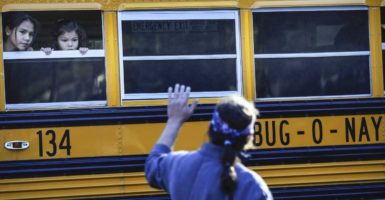“When you have a 50 percent graduation rate, you need to think outside the box,” Sen. John McCain, R-Ariz., declared about his proposal to rehabilitate some of the poorest performing schools in the country.
McCain introduced the Native American Education Opportunity Act, which recently passed out of the Senate Committee on Indian Affairs. The proposal would allow students who attend Bureau of Indian Education schools in states with education savings account (ESA) options to access federal Bureau of Indian Education funding in the form of an ESA to pay for any school or educational resource of their parents’ choice.
Education savings accounts are currently in place in Arizona, Florida, Mississippi, Tennessee, and Nevada. ESAs enable eligible children to access state funds that would have been spent on them in their assigned public school to pay for private school tuition, online learning, special education services and therapies, textbooks, curricula, and a host of other education-related services and products. Families can even roll over unused funds from year to year.
The Native American Education Opportunity Act would enable the children who attend Bureau of Indian Education schools—deemed some of the worst schools in America—to have the ability to receive an ESA worth up to 90 percent of the amount that would have been spent on them at the Bureau of Indian Education-funded school.
Parents could then use those funds to pay tuition at a private school of choice, along with any other education services and products they might want for their child, such as private tutoring, textbooks, and curricula.
With graduation rates in the 50s and test scores trailing their peers by double digits, students who are assigned to Bureau of Indian Education schools lack the educational opportunities needed to reach their career and life goals. Former Education Secretary Arne Duncan called the bureau’s system “the epitome of broken.”
What’s more, the condition of the schools is something the government has known about for over eight decades. As Politico reported:
It took 50 years for the federal government to admit officially that the education it had promised to provide Indian children was so bad it qualified as abuse. ‘Grossly inadequate,’ wrote the authors of a scathing 1928 report. Forty years later, the feds were taking themselves to task again, in a report by Sen. Edward Kennedy that called the state of Indian education a ‘national tragedy.’
Flash forward 46 more years. The network of schools for Native American children run by an obscure agency of the Interior Department remains arguably the worst school system in the United States, a disgrace the government has known about for eight decades and never successfully reformed.
Pouring more money into the schools is not a solution to the problem. To educate the 48,000 students who attend these schools, the federal government spends over $830 million annually.
Allowing parents to choose the school that best fits their child’s needs is not only what students at Bureau of Indian Education schools need, but also what the parents want.
According to Arizona state Sen. Carlyle Begay, who is Navajo, “hundreds of families applied within a matter of weeks,” when the state ESA program expanded to Native American families who live on tribal lands.
These schools have been falling behind for far too long. Students attending these schools deserve the opportunity to find learning options that work for them. Repurposing federal Bureau of Indian Education funding to empower these families with ESAs would be a great step toward achieving that goal.






























